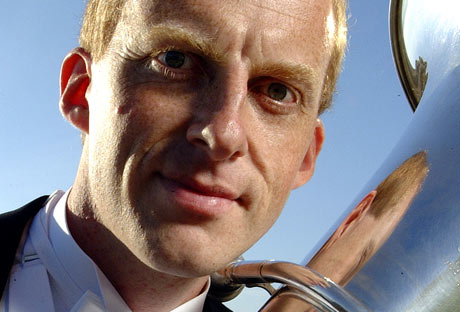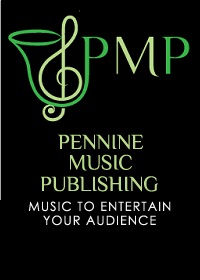4BR Interview - Oystein Baadsvik
6-Sep-20094BR's Chris Thomas talks to one of the great tuba players in the brass world - Oystein Baadsvik.

Øystein Baadsvik has done for the tuba what his fellow Scandinavian Christian Lindberg has done for the trombone.
Innovator
Away from the confines of the brass band world, his international reputation as a soloist, technical innovator and champion of new music for his instrument, have helped the tuba to reach soloistic heights on the classical stage that were hardly imaginable as little as ten years ago.
On one level, his upbringing in Norway might have drawn him into the adventurous brass band scene that has existed in his native country for many years now, yet despite a brief period with Ila Brass Band, he decided to pursue a rather different path and mission, ultimately succeeding in building a reputation for himself that has seen him appear as soloist with orchestra’s all over the world.
Artistic freedom
Again like Lindberg, Øystein Baadsvik’s close relationship with BIS records has given him a vital line of artistic freedom in his recordings and has resulted in a fruitful series of discs that has recently been further augmented by the release of 21st Century Tuba Concertos.
Featuring concertos by Fredrik Högberg, Jan Sandström and the leading Finnish composer, Kalevi Aho, the CD is a natural progression from the earlier release of 20th Century Tuba Concertos, which included the familiar yet effervescent Vaughan Williams Concerto and a Concerto from the pen of a very different Williams in the form of John, providing a fascinating glimpse into the world of the legendary film composer’s work for the concert hall.
Chris Thomas spoke with Øystein as he was preparing for a trip to Poland to play the Vaughan Williams Concerto with the Krakow Philharmonic.
Chris Thomas: At fifteen years of age, you were something of a late starter on your instrument. How did you come to the tuba and had you played any other instruments previously?
Øystein Baadsvik: True, it is a bit late. In fact I started playing the Euphonium in the local wind band at the age of 10. I don’t know if it was the instrument, my age or the teacher, but I simply didn’t get it, so I quit playing Euphonium after three years.
Two years after that I received an offer to play tuba in the same band. Since it was the only available instrument I went for it.
Chris Thomas: Given the active brass band scene in Norway, you were presumably conscious of the bands around you in your early days of playing?
Øystein Baadsvik: I started in a small school wind band, but soon got to know about the Ila Brass Band from Trondheim, my home city.
They are still one of the top Norwegian bands and listening to them back then of course made an impact.
Chris Thomas: Did you spend any time playing within brass bands in those early years?
Øystein Baadsvik: In the beginning there were only wind bands available for me to play in. We had very few brass bands in Trondheim, most of them being in the Bergen area.
But as I was a late starter on the tuba I had to catch up fast. After a year in the school orchestra I advanced to the community band, and then pretty soon I was playing Eb bass in Ila Brass Band.
Two years after I started on tuba I subbed in the Trondheim Symphony Orchestra and played in the Norwegian National Wind Band.
Chris Thomas: You won several major awards during the early part of your career. On reflection, do you feel those awards to have been significant breakthroughs for you?
Øystein Baadsvik: Competitions were important to me for several reasons. After having played for two years, I won a regional solo competition for all wind instruments.
That gave me the self confidence that is so crucial in this business. Full of that self confidence, I went for the national solo competition the next year and failed magnificently.
I didn’t even make it to the second round. That was tough, but it taught me to be humble and never take success for granted. The following year I practiced hard and methodically. I went back and won the national solo competition for wind players.
That taught me that you can’t trust your talent alone. It needs hard work to go with it. I have learnt that in a stressed situation it is not enough to know the piece that you are playing. You must also know that you know it.
Feedback from leading musicians in the jury helps you to add to your musical knowledge and learn about your strengths.
Chris Thomas: In your early days as a player were you frustrated by the lack of serious repertoire for the instrument and was it an immediate preoccupation that you needed to do something about it?
Øystein Baadsvik: In the early days I played what was available and the lack of repertoire for tuba didn’t stop me from playing around with my mother’s trumpet music. In general I was very much driven by the “having fun” factor. For example, I borrowed my neighbour’s two track tape recorder and recorded duets with myself.
I recorded whatever I could lay my hands on. Opera duets, trumpet duets, piano scores, violin duets.
Composing new music for tuba has never been an idealistic or political choice for me. It was and still is something I do because there is a specific story to be told and I happen to be the only person that can tell just that story.
I have usually commissioned music from other composers because there was a specific occasion, a concert or a recording.
Chris Thomas: Looking back, who do you consider to have been the major influences on your own playing and as a musician generally over the years?
Øystein Baadsvik: I remember my mother always used to say that there are only two types of music; good music and bad music. When she, my sister, brother and I went to the brass band rehearsals my mother used to feed us with her conception of good music on the car radio.
Jazz like Miles Davies, Coltrane, Dizzie, Lester Young and Charlie Parker, but also recordings of Maurice André, the Philip Jones Brass Ensemble and other brass music. We also of course listened to pop and rock music.
I have always been extremely intrigued by how the inner mechanics of music work, so the big question was what actually makes this good music? Is it only a matter of taste, something you learn to like or does there actually exist an exact universal scale for measuring the quality of music?
For me personally, it often boils down to credibility. If the musician is sincere and really seems to believe in what he is doing he is half way there. The other half is having the technique to pull it off. That approach does have some consequences.
For example, I will enjoy an unorthodox rendition of a piece as long as the musician is convincing and the interpretation seems honest and well thought through. I would much rather hear that than a spiritless, non-personal, faked musical, “perfect” performance. Actually, few things annoy me more than musicians faking honesty.
Chris Thomas: Amongst other things, you have collaborated with jazz and rock musicians during your career. Is it important to you that the instrument is taken into new musical territory wherever possible?
Øystein Baadsvik: I might have said something like that in previous interviews but honestly, my leading star has always been the joy of playing and the joy of exploring new musical territories.
That being said, from a strictly “political” standpoint, taking the tuba to new musical venues is of course good.
Chris Thomas: You have become known for your development of extended playing techniques for the tuba. Could you tell us something of how you have tried to create these new techniques and what they involve?
Øystein Baadsvik: First a few words on developing ideas. We are all struck by good ideas from time to time. In the beginning they seem brilliant and we smile to ourselves just thinking about it.
But if nothing is done to nurse the idea it fades away and dies within days or weeks and what was once a potential super-idea ends up being a grey memory.
The process of nursing and developing a good idea needs a creative and non-judgemental environment. Surround yourself with curious people that encourage and support. Even the most monumental symphonies, books or movies were once a tiny fragile idea in one person’s head.
In practice for me, this has meant that in addition to the daily routines with scales and all the rest, I would set aside 30-40 minutes each day dedicated to fun and fooling around. During those minutes everything was allowed and nothing was sacred.
I called it my flying hour and it was my reward after a rigorous practice session.
Chris Thomas: And some of these techniques were used in your own piece, Fnugg?
Øystein Baadsvik: Definitely. If you watch the You Tube video of Fnugg, “How it all started”, I tell the true story about the tune’s origin. My teacher told me to play the double tongue in the low register.
I practiced and practiced but it all sounded like a helicopter instead of a tuba, so my teacher asked me not to do that anymore. With my usual “disrespect”, I continued secretly anyway and added accents to some of the notes. Later I discovered more sounds that also fitted into the rhythm that was now an almost percussive groove.
I had been doing complicated multiphonics in pieces like Encounters II for solo tuba but discovered that no one had explored the potential in just doing octaves and changing the vowel to alter the overtones.
That, in combination with the groove and an almost folk music like theme, was the birth of Fnugg.
In other words, the tune was never composed note by note, but grew organically.
Chris Thomas: What kind of daily practice regime and structure do you adhere to?
Øystein Baadsvik: Being on the road close to 200 days a year I have become an opportunist, grabbing an hour here and there when I find time.
I once used to follow a very strict regime though and would play from 8am to 5pm. Everything was planned ahead, even which pieces and parts of a piece to practice. I played in blocks of 20 minutes followed by a 10 minutes break.
Lunch break was one hour. If the phone rang in a middle of a block I would not answer. I would not accept freelance jobs during this period of the day, meaning that I had to live on very little money. Soup made from potatoes and onion was a hit!
Chris Thomas: In England particularly, where the instruments are comparatively uncommon, some people might be intrigued by your playing of a rotary-valved Miraphone tuba. What do you find the benefits and characteristics of the instrument to be over and above more “conventional” instruments?
Øystein Baadsvik: I have never liked the word conventional, but here is the reason I play the Miraphone rotary E flat. As most young tubists in Norway do, I started on an E flat, “conventional” with upright piston valves!
The problem with that tuba (I will not mention the brand!) was that the valves would constantly stick. My teacher played a Hirsbrunner C, with front action rotary valves and I envied him for the smooth and secure action of those valves.
For that reason I wanted rotary valves but saw no reason to abandon the E flat. At that time Hirsbrunner had a good E flat with rotaries so I bought it. When I started my studies at the Royal Academy in Stockholm my teacher Michael Lind told me to get an F. That’s what the pro’s play.
I had then and I still have a hard time understanding that the difference between a pro and an amateur is the key of the tuba. In fact, I still claim that not even the most experienced tuba players in the world are able to hear the difference between a rotary E flat and a rotary F without seeing it; sometimes not even then.....it is a much bigger difference between the British rotary style and the German rotary style.
I like the shorter stroke on a rotary, 16 mm compared to 25 mm and I like the more direct sound that the smaller bell provides. The fact that it is lighter is also good when travelling.
In 2001 I was offered the opportunity by Miraphone to help develop a new E flat. We eventually decided to go for two models that are now called Norwegian Star and Starlight.
The latter is the smallest one and the one I use all the time.
Chris Thomas: What do you consider to be the masterworks for the instrument given the repertoire that now exists? The Vaughan Williams Concerto must figure highly on most tuba players lists?!
Øystein Baadsvik: Definitely. The Vaughan Williams is the piece I most often play with orchestras. The John Williams Concerto is also one of my favourites.
Chris Thomas: Your recently released CD, 21st Century Tuba Concertos features a Scandinavian full house of concerti by Fredrik Högberg, Jan Sandström and the Finnish master, Kalevi Aho. Could you tell us something of what we can expect from the music?
Øystein Baadsvik: They are three very different composers. Högberg is very immediate, expressive and fun. His second movement has already been described by critics as an overwhelmingly beautiful song with references to film music.
His teacher Jan Sandström became famous with his Motorcycle Concerto and in his Concerto, “The Lemon House”, the most significant feature is the singing voice of the tuba with the orchestra. Some of the movements contain the most difficult passages I have ever played on the tuba.
The Finn Kalevi Aho is arguably one of the greatest Nordic composers alive and delivers real music. No excuses, no prisoners, just very, very good music. It is extremely exhausting to play, both physically and mentally.
Chris Thomas: Do you see it as encouraging that there are new tuba talents emerging from the brass band world, Les Neish in England for one example and who in some cases are also commissioning new works?
Øystein Baadsvik: It is great. I encourage all activity that will bring the instrument forward. There is still room for a lot more tuba soloists!
Chris Thomas: In your experience, do you see the tuba as having become more accepted and respected as a solo instrument in the wider musical world in recent years?
Øystein Baadsvik: The grand old man of American tuba playing, Harvey Philips, says that every tubist on the planet represents all other tubists. This is how I interpret his words; every time a tubist plays in front of an audience he is shaping the general public’s opinion of the tuba.
One bad performance can destroy 200 people's view on the tuba but one good performance can turn those people into "believers". If the tuba player plays boringly people tend to blame the instrument, “what did I tell you? The tuba is obviously not a solo instrument, that guy just proved it”.
On the other hand, if a violin player plays badly, the performance will not hurt the violin’s reputation as a solo instrument at all. It will only hurt the performer’s reputation. That is a huge difference that comes from the fact that the tuba is still very young.
As for myself, I have to thank Mr Robert von Bahr, the owner of BIS Records, for his courage to sign me up as an artist. Letting me release whatever I want on BIS, the seventh largest classical label in the world, has definitely made it easier to reach out to a large, general audience.
BIS CD's are regularly reviewed in publications like the New York Times, Gramophone, BBC Radio and The Daily Telegraph which also helps.
So, are we getting up there with the violin? Not yet and I'm afraid that we never will do, but here is the good news. Many people, and not only tuba players, actually find that the tuba speaks to them in a way that a violin never can. That makes me happy.
Chris Thomas: Having expanded the tuba’s repertoire and brought the instrument to public attention in the “classical” world, do you still have any remaining ambitions to fulfil?
Øystein Baadsvik: Yes I do. For instance, I am releasing a new CD in February 2010 with the string orchestra Trondheim Soloists and the jazz pianist and composer Erlend Skomsvoll. The music is mainly composed by the pianist and me and it will represent a small revolution when it comes out.
The instrumentation, the expression, the music, the arrangements, are all totally new and don’t resemble anything that I have created or recorded earlier. I am also trying out some even newer playing techniques on that CD! And from there?
In May next year, I record my own Tuba Concerto which was premiered this April. Later in 2010 I am recording a CD with the Dutch Army Band which will feature all new music and in 2011 I'll record a CD of Christmas music for solo tuba, full symphony orchestra and female choir. That I think will become insanely beautiful.
Oh, and here's a secret...I’d like to do an electric tuba show... light, smoke, surround sound and video. Just give me some spare time...
Chris Thomas: And presumably there are plenty more composers you would like to commission given the chance?
Øystein Baadsvik: Absolutely, I have a secret wish list. Many composers actually contact me about playing their music.
I recommend that composers also contact an orchestra or a band directly about writing a piece for tuba and orchestra or band. Maybe even tie it to a specific event like a festival, a recording, a celebration, an anniversary etc.
If a composer comes directly to me with an idea I might be able to find an orchestra and a concert opportunity, but the chances are that the composer might do an even better job promoting his own idea.
Chris Thomas: We shall look forward with interest to those forthcoming CD’s! Thanks for taking the time out to talk to us.















